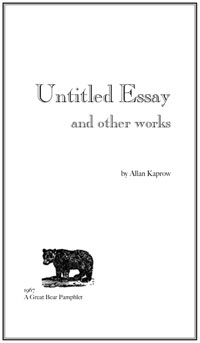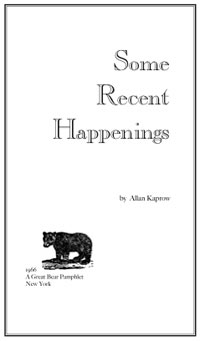

|
 historical historical
 ubuweb ubuweb
|
Allan Kaprow, USA | 1927-2006 
 Untitled Essay and other works (1967, Great Bear Pamphlet, Something Else Press) [PDF, 796k] Untitled Essay and other works (1967, Great Bear Pamphlet, Something Else Press) [PDF, 796k]

 Some Recent Happenings (1966, Great Bear Pamphlet, Something Else Press) [PDF, 592k] Some Recent Happenings (1966, Great Bear Pamphlet, Something Else Press) [PDF, 592k]
 How To Make A Happening (1966) [PDF, 112k] How To Make A Happening (1966) [PDF, 112k]
 Push and Pull: A Furniture Comedy for Hans Hoffman Push and Pull: A Furniture Comedy for Hans Hoffman
[from Aspen 6A]  Alan Kaprow Interview (1988, John Held. Jr.) Alan Kaprow Interview (1988, John Held. Jr.) Alan Kaprow -- "Art Which Can't Be Art" (1986) Alan Kaprow -- "Art Which Can't Be Art" (1986) Alan Kaprow -- "The Education of the Un-Artist" Part 1 (1972) [PDF] Alan Kaprow -- "The Education of the Un-Artist" Part 1 (1972) [PDF] Alan Kaprow -- "The Education of the Un-Artist" Part 2 (1972) [PDF] Alan Kaprow -- "The Education of the Un-Artist" Part 2 (1972) [PDF]Allan Kaprow AMERICAN PAINTER, ASSEMBLAGIST, CREATOR OF HAPPENINGS and theorist, born 1927 in Atlantic City, New Jersey. Within a brief and intense early career, Kaprow progressed from an interest in Abstract Expressionism and many-levelled paintings incorporating collage to assemblage. He enrolled in Hans Hofmann's painting school (1947-48). Through Hofmann he began to develop an expressive, high spirited style of action painting, based on real landscapes and figures, which was to lead, by a number of well-defined and documented steps, to the happenings of a decade later. With a number of Hofmann's students he cofounded the Hansa Gallery (named after their teacher), a cooperative artists gallery on East 10th Street in Greenwich Village. He soon moved away from the single art object or picture frame to environments and to a new art form called Happenings. The paintings he showed at the Hansa Gallery in New York (1952) revealed an attempt to use many types of images and orientations within one work. In regular shows there from 1953, his paintings became increasingly wild, energetic and three-dimensional. "I had begun to clarify, even then, what was a multi-leveled attitude toward painting." he wrote. Early Influences Some rudimentary assembled constructions were also exhibited, and from these Kaprow developed an "action-collage" technique in which he employed such materials as straw, wadded newspaper, twine and flashing lights. Influenced by the kinaesthetic paint-dripping methods of Jackson Pollock, as well as by the Abstract Expressionists' emphasis on the act of painting itself, Kaprow became a crusader for artist-spectator involvement over an extended field of operation. Pollock and the avant-garde composer John Cage were the two major influences that steered Kaprow to the first happenings. The work of Pollock, the apotheosis of an art of action, provided Kaprow with a rationale to progress beyond traditional painting. An exhibition of Pollock's work provided the inspiration for Kaprow's own experiments in the total, enveloping environment they created. In a 1958 ArtNews article, "The Legacy of Jackson Pollock," Kaprow wrote that his canvases were so huge and all-embracing that "they ceased to become paintings and became environments"; they pointed the way to a new form of art in which "action" would predominate over "painting." "Objects of every sort are materials for the new art: paint, chairs, food, electric and neon lights, smoke, water, old socks, a dog, movies, and a thousand other things...." In fact this was the way Kaprow's own art was developing: toward what he called "action-collages" (as in Penny Arcade,1956, and Wall, 1957-9). The other major influence was that of Cage. While he still made assemblages and painted such constructions as Grandma's Boy (1956, Pasadena, California Museum), between 1956 and 1958 Kaprow was studying musical composition with the avant-garde composer John Cage at the New School for Social Research in Manhattan. The notions of chance and indeterminacy as a valid means of aesthetic organization (and disorganization) that Cage advocated were instrumental to Kaprow's subsequent thinking and artistic activity. No kind of experimentation was anathema to Cage, the most radical and influential native modernist in American music; at the time, his direction was "towards theater" -- where, he believed, could be found the most effective integration of art and "real" life -- and all his students were thus propelled. In 1957-8 Kaprow began to create environmental works that demanded audience participation (an idea also stemming from Cage's experiments), and this integration of space, materials, time and people eventually led to the more experimental pieces. Secondary influences -- really, precedents -- for Kaprow's happenings were the publicly staged absurdities of the post-World War I Dadaists, the theories of Antonin Artaud, and the escapades of Yves Klein, the French New Realist. In 1965 Kaprow explained his evolution from collage to environments and happenings: "The action collages then became bigger, and I introduced flashing lights and thicker hunks of matter. These parts projected further and further from the wall into the room, and included more and more audible elements: sounds of ringing buzzers, bells, toys, etc., until I had accumulated nearly all the sensory elements I was to work with during the following years...." His works expanded until they filled the gallery, creating an integrated environment for the spectator. "I immediately saw that every visitor to the environment was part of it. And so I gave him opportunities like moving something, turning switches on -- just a few things. Increasingly during 1957 and 1958, this suggested a more 'scored' responsibility for the visitor. I offered him more and more to do until there developed the Happening.... The integration of all elements -- environment, constructed sections, time, space, and people -- has been my main technical problem ever since." Kaprow's progress did not occur in a vacuum, as he readily acknowledges. Robert Rauschenburg, Claes Oldenburg, and Jim Dine, among others, were also working on theatrical pieces, although they soon returned to more traditional areas; In Europe, Wolf Vostell and the Fluxus Group, and in Japan, the Gutai Group, were all investigating similar directions.
The first such work was called "18 Happenings in 6 parts" -- presented in October 1959 at the Reuben Gallery on Fourth Avenue in New York. It is from this performance that the now-famous term "happening" is derived: used originally to indicate a very determined, rehearsed and heterogenous production, the word has picked up the connotation of a spontaneous undirected occurrence -- a meaning not altogether intended by Kaprow's entitling of the original event. He had divided the space into three rooms with clear plastic walls. The visitors, whose tickets directed them to specified seats in each room at particular times and with strictly choreographed movements, witnessed, among other events, a girl squeezing oranges, an artist lighting matches and painting, and an orchestra of toy instruments. Rauschenberg, Jasper Johns, Alfred Leslie, and Lester Johnson were among the performers. Altough tightly scripted and planned, Kaprow's early happenings maintained an air of unstructured spontaneity. This was because they had none of the usual trappings of theatre -- plot, dialogue, character, or professional performers -- and no resemblance to the traditional visual arts. According to drama critic Richard Schechner of the New York Times, what Kaprow and others in the field were producing was "a new theater [that] combines associative variations on visual-aural themes, chance permutations, games and journeys." 18 Happenings in 6 Parts was quite successful, and for a time happenings and performances by Kaprow and others were eagerly sought out (they were sometimes hard to find, being staged in lofts, empty lots, stores, classrooms, train stations, and other unconventional places) by the fashionable looking for the latest trend. Undoubtedly, this period of trendiness helped inject the term "happening" into the idiosyncratic vocabulary of the 1960s. Encouraged, Kaprow regularly staged events in the New York City area through the decade. After 1960 he devoted himself to publicizing, creating and establishing the happening as a viable form of art in America. His concern, like that of such early Pop artists as Robert Rauschenberg, Robert Whitman, Claes Oldenburg and Red Grooms, with whom he originated this all-encompassing form of environmental theatre, has been to break down the traditional distinctions between life and the categories of art. Among the events he staged at this time were Apple Shrine(1960, at the Judson Gallery, Greenwich Village, which he directed), A Service for the Dead (1962), Eat (1964, at the Old Ebling Brewery in the Bronx), and many others. In Coca Cola, Shirley Cannonball?(1960), a huge boot (of cardboard) kicked an oblate ball around a school gymnasium to the beat of a fife and drum, while in A Spring Happening (1961) the audience was terrorized by a power mower and an electric fan "attacking" them in a dark tunnel. In Words (1962), spectators were invited to rearrange words painted on cardboard on the gallery walls. For the Museum of Modern Art's "Hans Hofmann and His Students" travelling show, Kaprow created Push and Pull: A Furniture Comedy for Hans Hofmann, which consisted of two furnished rooms that could be rearranged by visitors. (Some older women, Kaprow noted, were appalled and began to houseclean.) In this attempt to enlarge the realm of art beyond gallery display and museum situations, many of the happenings have been performed in such untraditional settings as lofts, stores, gymnasiums and parking lots. Yard (1961), for example, consisted of a backyard full of rubber auto tires heaped radomly for viewers to climb in and around. The Theory of Happenings The happening, as Kaprow developed it, is a non-verbal, theatrical production that abandons stage-audience structure as well as the usual plot or narrative line of traditional theatre. Although a compartmented organization may be used, the performers are considered as objects -- often kinaesthetically involved -- within an overall design of environment, timing, sound, colour and light. Found environments are often used and built upon, but the events are not casually arrived at, nor are they entirely accidental and spontaneous. His view was that the Assemblage was to be "handled and walked around", the environment" was to be "walked into", but the happening was to be a genuine "event" involving spectator participation and no longer confined to the museum or gallery. Performers are encouraged to capitalize upon unplanned occurrences while acting out fantasies based on real life within a certain roughly pre-ordained structure that suggests symbolic and universally basic themes and meanings. A field of aesthetic operation is thus created in relation to life, combining artfully determined materials with strong associational properties, and dimensions with events and things from the sphere "outside" of customary definitions for art. Kaprow now teaches in the Visual Art Department of the University of California at San Diego. He is the author of more than one hundred journal articles and a number of books, films and videotapes about his happenings and performances. There is no doubt that his work helped spawn the flourishing performance art movement, especially on the West Coast and in Europe. cf. Allan Kaprow. Assemblage, Environments, and Happenings, New York 1966.
Compiled from: Phaidon Dictionary of Twentieth Century Art; |